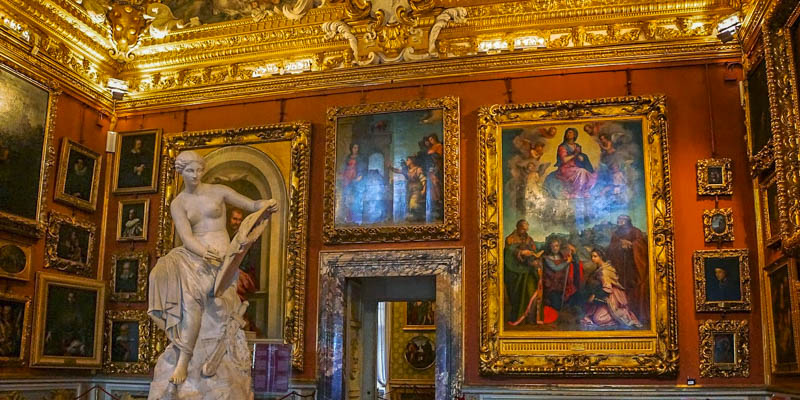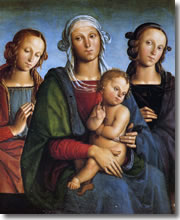

If the Uffizi represents mainly the earlier masterpieces collected by the Medici, the Pitti Palace's painting gallery continues the story with the High Renaissance and later eras, a collection gathered by the Medici, and later their heirs, Grand Dukes of Lorraine.
It is chockablock with paintings by Caravaggio, Raphael, Titian, and Rubens—and many or the rooms are elabroately fescoed by 17C baroque master Pietro da Cortona—this was, after all, the piano nobile ("noble floor") of the palazzo, where the Grand Dukes themsleves lived.The works are still displayed in the old-world fashion, which hung paintings according to aesthetics.
In other words, rather than a didactic parade of paintings arranged chronologically or by school, it's a more aesthetic arrangement along the lines of: "Hmm, now does this Raphael go with those drapes, or should we put the Rubens there instead?"
Love it.
After a long Galleria delle Statue "Hall of Statues"—filled with Roman-era marble busts and a 19th-century tabletop inlaid in pietre dure, an exquisite example of the famous Florentine mosaic craft—are a series of five rooms that once made up the Medici's main apartments, frescoed by Pietro da Cortona in the 17th-century baroque style. These are home to the bulk of the paintings.
The "Venus Room "is named after the neoclassical Venus Italica, which Napoléon had Antonio Canova sculpt in 1810–12 to replace the celebrated ancient Venus de' Medici the Emperor had appropriated for his Paris digs back in 1803. Joke's on him; just three years later, after Napoléon fell, the Medici Venus was returned to the Uffiizi's tribune, where it remains, so Florence ended up with both statues out of the deal.
Four masterpieces by the famed early 16th-century Venetian painter Titian hang on the walls.
Art historians still argue whether The Concert ★ was wholly painted by Titian in his early 20s or by Giorgione, in whose circle he moved. However, most now attribute at most the fop on the left to Giorgione and give the rest of the canvas to Titian.
There are no such doubts about Titian's Portrait of Julius II (1545–46), a copy of the physiologically penetrating work by Raphael in London's National Gallery (the version in the Uffizi is a copy Raphael himself made), or Titian's Portrait of a Lady ("La Bella") (1530s).
Titian painted the Portrait of Pietro Aretino (1545) for the writer/thinker himself, but Aretino didn't understand the innovative styling and accused Titian of not having completed the work. The painter, in a huff, gave it to Cosimo I as a gift.
The room also contains Rubens's Return from the Hayfields, famous for its classically harmonious landscape and early-sunset colors, and works by Sebastiano del Pimbo, Tintoretto (a nice oblong family scene of Venus, Cupid, and Vulcan), Salvator Rosa (his 1640s Harbour st Sunset was clearly influenced by Claude Lorraine's similar take in the Uffizi), and Guido Reni.
The "Apollo Room" has another masterful early Portrait of an Unknown Gentleman (c. 1540) by Titian as well as his sensual, luminously gold Mary Magdalene ★ (1530/35),the first in a number of takes on the subject the painter was to make throughout his career.
There are several works by Andrea del Sarto, whose late Holy Family (1523) and especially Deposition (Luco Pietà) (1523-24) display the daring chromatic experiments and highly refined spatial compositions that were to influence his students Pontormo and Rosso Fiorentino as they went about mastering Mannerism.
Also check out Guido Reni's Cleoparta pinching an itty-bitty asp by her bared breasts, a late High Renaissance work done in a monumental style that would later influence Neoclassicism.
The "Mars Room" is dominated by Rubens, including the enormous Consequences of War ★★ (1638), in which Venus trying vainly to stop Mars from going off to war whiel a haggard Fate pulls the god into battle, trampling the Arts and underfoot and casting humanity into darkness. An aged Rubens, two years from death himself, painted this for his friend Sustermans (the Medici court painter) at a time when both were worried that their Dutch homeland was on the brink of battle.
Rubens's The Four Philosophers ★ is a much more lighthearted work, in which the artist painted himself at the far left, next to his seated brother Filippo.
The great Venetians are also represented here, with Tintoretto's Portrait of Alvise Cornaro (1460s), Paolo Veronese's Portrait of a Gentleman in a Fur Cloak, and Titian's Portrait of Ippolito de' Medici (1533) in which the young bastard son of Giuliano, Duke of Nemours, wears the Hungarian get-up he had worn as the leader of 4,000 harquebusiers in the defense of Vienna against the Turks. Young Ippolito would be dead by 1535—officiall yfrom malaria, but possibly poisoned by his own cousin, Duke Alessandro de' Medici (who, two years later, would himself be murdered in bed by yet another cousin, Lorenzaccio de' Medici, during a staged tryst with "a beautiful widow"; Lorenzo the Magnificent's line of Medici family died out pretty scandalously).
The star of the "Jupiter Room" is Raphael's La Velata ★★, one of the crowning achievements of his short career and a summation of what he had learned about color, light, naturalism, and mood. It's probably a portrait of his Roman mistress called La Fornarina, a baker's daughter who sat for many of his Madonnas.
Don't miss Andrea del Sarto's early Annuncaition and St. John the Baptist
In the Madonna of the Sack, you can also see how Perugino's use of space and atention to detail influenced his young student Raphael.
Raphael is the focus of the "Saturn Room" ★★, where the transparent colors of his Madonnas and probing portraits show the strong influence of both Leonardo da Vinci (Raphael's Portrait of Maddalena Strozzi Doni owes much to the Mona Lisa) and Raphael's old master Perugino, whose Depositionand a Mary Magdalene hang here as well.
The "Illiad Room" has another Raphael portrait, this time of a Pregnant Woman ★, along with some more Titian masterpieces.
Rosso Fiorentino's mannerist Madonna Enthroned with Saints (1522) was painted for the altar of the Dei Chapel in Santo Spirito church, a cramped space at the top of some steps. As such, Fiorentino crammed the figures into and around the painted niche at the center. However, when the painting was moved to the Pitti in the late 17th century, another artist enlarged the work significantly (you can clearly see the seams), opening up the visual space and projecting more figures into it, utterly ruining the enclosed effect.
Don't miss Artemesia Gentileschi's Mary Magdalene and Judith ★, two paintings by one of the only female artists of the late Renaissance era, an artist who often turned to themes of strong biblical women.
From here, you enter a series of smaller rooms with smaller paintings.
The "Room of Jupiter's Education" has two famous works. Caravaggio painted the Sleeping Cupid ★★ (1608) while living in exile from Rome (avoiding murder charges) on the island of Malta.
Cristofano Allori's Judith with the Head of Holofernes ★ is a Freudian field day where the artist depicted himself in the severed head, his lover as Judith holding it, and her mother as the maid looking on.
In the Sala di Berenice is Caravaggio's 1608–09 Tooth-puller ★, a frankly disturbing take on an everyday scene (and one for which the attrtibution has been in question since at least a 1637 inventory of Pitti paintings).
In the Sala delle Belle Arti is Peter Paul Rubens’s early Risen Christ ith a rather energentic Jesus shedding his shroud hopping off his tomb slab.
» On to the Appartamenti Reali
Piazza Pitti (cross the Ponte Vecchio and follow Via Guicciardini; you can't miss it)
tel. +39-055-238-8614
www.polomuseale.firenze.it
Tickets: Select Italy
Galleria Palatina, Appartamenti Reali, and Galleria d'Arte Moderna:
Tues–Sun 8:15am–6:50pm
Galleria del Costume, Museo degli Argenti, Boboli Gardens, and Museo delle Porcellane:*
Tues–Sun as follows:
Jun-Aug 8:15am–6:50pm (Boboli Gdns: to 7:30pm)
Apr-May, Sept-Oct 8:15am–6:30pm
[portions of Oct and Mar after/before switches daylight savings time: 8:15am–5:30pm]
Nov-Feb 8:15am–4:30pm
* Museo delle Porcellane closes 15 min. earlier
Museo delle Carrozze: Currently closed
(Pitti Palace is free the first Sunday of each month)
Tickets: Select Italy
Firenze Card: Yes
Bus: C3, D
Hop-on/hop-off: Pitti (A)
Planning your day: Budget at least two hours for a cursory visit of just the Galleria Palatina and Appartamenti Reali.
If you plan to venture into
the Boboli Gardens, give it another hour.
If you have only passing interest in the other museums, each will take about 20 minutes.
Note that the last entry for every museum or part of the Pitti complex is 1 hour before closing.
The major parts of the Pitti Palace complex (Galleria Palatina, Apartamenti Reali, Boboli Gardens, and Porcelain Museum) are covered by the Firenze Card—free admission, no waiting in line. » more
If all you're into is the art, you can get a ticket covering just the Galleria Palatina and Modern Art Gallery for €8.50.
If, however, you'd like to wander the rest of the collections (and gardens) as well, don't spend another €6 or €7 on the separate collective ticket. Instead, get the "biglietto cumulativo," an all-access pass for €11.50 that lets you into all the Pitti galleries, apartments, and gardens for three days.
Or just use the Firenze Card.
Take a guided tour of Palazzo Pitti with one of our partners:
Pitti Palace tours
Boboli Gardens toursWarning: The Pitti Palace seems to revel in closing a handful of its (lesser) museums for years at a time—lately, it seems to be the collection of fancy carriages in the Museo dell Carozze.
Just which ones will be closed at any given time and for how long works on some mysterious schedule I have yet to discern. Check before visiting if missing, say, the costume gallery or the porcelain museum will spoil your vacation.
Share this page
Search ReidsItaly.com
Piazza Pitti (cross the Ponte Vecchio and follow Via Guicciardini; you can't miss it)
tel. +39-055-238-8614
www.polomuseale.firenze.it
Tickets: Select Italy
Galleria Palatina, Appartamenti Rrali, and Galleria d'Arte Moderna:
Tues–Sun 8:15am–6:50pm
Galleria del Costume, Museo degli Argenti, Boboli Gardens, and Museo delle Porcellane:*
Tues–Sun as follows:
Jun-Aug 8:15am–6:50pm (Boboli Gdns: to 7:30pm)
Apr-May, Sept-Oct 8:15am–6:30pm
[portions of Oct and Mar after/before switches daylight savings time: 8:15am–5:30pm]
Nov-Feb 8:15am–4:30pm
* Museo delle Porcellane closes 15 min. earlier
Museo delle Carrozze: Currently closed
(Pitti Palace is free the first Sunday of each month)
Tickets: Select Italy
Firenze Card: Yes
Bus: C3, D
Hop-on/hop-off: Pitti (A)